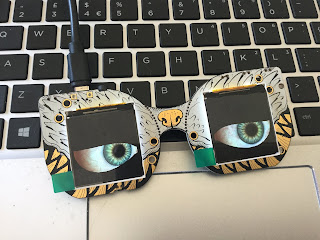One of the things I enjoy is a subscription to Adabox from Adafruit, receiving the box and very soon before that finding out what the main item is the box is a treat. The latest, at the time of writing, is AdaBox 13 with the MONSTER M4SK a set of small screens, based around 240x240 IPS TFT displays, acting as moving eyes in a mask, along with a couple of masks, speaker, microphone, lenses, etc and craft materials for decorating a mask - a full list can be found here.
My goal was, to play with this, was to create a slightly creepy mask where the eyes move - a simple build but fun to do. The Adafruit quick start guide for this (available here) provides all the instructions on setting it and downloading the different sets of eyes (that is really creepy to write). A set of different graphics files are already available for different sets of eyes; a couple of examples are shown below.
One suggestion is when you download the files for the eyes - still creepy - keep a copy elsewhere, in one case I accidentally delete the configuration file I want so it was handy to have a backup.
Two masks are included in the box, being lazy, I choose the already decorated silvery mask to use. Along with the M4SK device, a set of lenses and holders are included. I struggled a bit with fixing the lenses into the holder and attach to the device - in the end, I choose to leave them out and stick the M4SK to the mask without them. A video of the mask in action is shown below.
There is much to explore with the Monster M4SK including a number of sensors already on the board including a capacitive touch sensor, buttons, a light sensor, a port for connecting a PDM microphone (included in the AdaBox 13). and three other ports. Sound effects can be played from a headphone socket or via a built-in amp driving an 8-ohm 1W speaker (also included in the Adabox). A Lipoly battery can be connected. A guide to getting going via the Arduino IDE is available here.
Related links
- Adabox 13
- Quickstart guide and files
- Information of producing your own eye graphics
- Through Arduino IDE
All opinions in this blog are the Author's and should not in any way be seen as reflecting the views of any organisation the Author has any association with. Twitter @scottturneruon



















